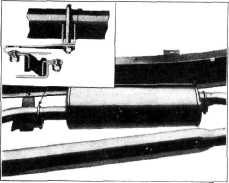1942 - 1947 CHEVROLET SHOP MANUAL
Section 8 - Fuel Tank & Exhaust System
|
|
|||
|
8-3 |
|||
|
|
|||
|
providing
additional road clearance. Basically there are three perforated tubes: inlet,
intermediate, and outlet. The
inlet and outlet tubes are encased by separate perforated tubes. The primary
purpose of these encasing
tubes is to prevent short circuit of the gases, which try to flow
through the perforation in the
inlet tube directly to the outlet tube, carrying noises with them and causing
noises at the end of the tail pipe at low speeds.
Incorporated in the front end of
the muffler is a resonance chamber,
with a narrow annular opening around the inlet pipe. The volume of
this chamber is such that
"period" noises, which usually occur in exhaust on coasting, are
tuned out.
The gas flow from the engine,
considerably straightened out by the
small exhaust pipe, reaches the muffler through the inlet tube,
reverses at the rear end and flows
from tube to tube to the outlet as shown. The flow, however, is not
restricted to the tubes,
since the gases pour out in jets from each perforation, mingling
with the gases from adjoining tubes.
The resulting mixing and baffling, with velocity changes and
reversals in direction of flow, aids in silencing.
Every part
of the muffler is attached to the assembly by electric arc welding, making
failure or rattling practically
impossible.
TRUCKS
The truck
exhaust system includes such items as
a unit muffler of integral construction, employing the reverse flow and diffusion
principles used so successfully on the passenger cars to obtain
quiet operation, Fig. 4, heavy tail
pipe metal for durability, and
a large diameter tail pipe to reduce back pressure. The tail pipe extends back
of the rear axle to the end of the chassis, discharging exhaust gases at a point that prevents fumes
entering the driver
compartment. |
PASSENGER CARS
The center mounting directly back
of the muffler is a vulcanized rubber
cushion design. This holds to
a minimum the transfer of any exhaust vibrations to the frame and body, Fig.
5. |
||
 |
|||
|
Fig. 5—Passenger Muffler Mounting
The rubber
cushion is mounted to the muffler outlet pipe, and the support is on a frame
bracket. The tail pipe support
consists of a rubber grommet located on a separate bracket riveted to
the rear cross member. The
rubber grommet is held in controlled suspension by a spacer, insuring
proper tension on this mounting at all times.
Locating
lugs and slots on the exhaust pipe, muffler inlet and outlet pipes and tail
pipe insure proper assembly and
correct angular relation and lineup of all parts.
There are
three points to consider when installing a muffler and tail
pipe.
1. The oval section of the muffler should lie
in a horizontal
plane.
2. There should be 5/8" clearance between the
underside of the floor pan and
the tail pipe at the
kick-up.
3. The tail pipe support at the rear must be
assembled in a vertical
position. If it is at an angle
the tail pipe is apt to strike the bumper.
TRUCKS
The muffler
end of the exhaust pipe slides into the muffler inlet pipe and is held in place
by a clamp. Small projections
on the exhaust pipe properly
locate the exhaust pipe depth in the muffler.
A bracket
extending from the frame, with the underside conforming to the curvature of
the |
|||
 |
|||
|
Fig. 4-Truck Muffler
EXHAUST SYSTEM SUSPENSION
When
installing a muffler, exhaust pipe or tail pipe assembly, care should be
taken to have the proper assembly and
relationship of each part or assembly to the other. Incorrectly
assembled parts of the exhaust
system are frequently the cause of annoying rattles due to incorrect
clearances, and unusual noises,
difficult to locate, because of some change or obstruction to the normal
flow of exhaust gases through
improper mounting. |
|||
|
|
|||